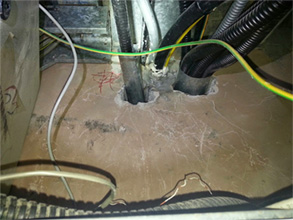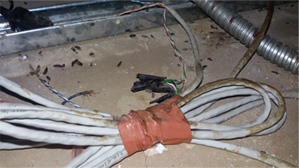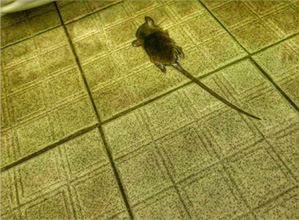Introduction
Rodents including mice and rats are commensal, most of them are nocturnal and active year-around. Most rodents are relatively small and very active which requires much food to supply the needed of energy. They have the highest mammalian reproductive capacity which may help them compensate for high predation losses.
Among different species of rodent, house mouse, Norway rat and roof rat are human’s most serious pests because they eat or contaminate stored foods (at least 20% of world’s food supply), damage or destroy vast amount of materials, and transmit or spread disease.
Signs of infestations of rodent include: gnaw mark, droppings, footprints, rub marks or greasy markings, burrow, and damaged goods.
House Mouse
The house mouse is the most commonly encountered and economically important of the commensal rodents. House mice are not only a nuisance, damage/destroy materials by gnawing, and eat and contaminate stored food, they are also of human health importance as disease carriers or vectors. It is thought to be of Central Asian origin, but is now of worldwide distribution.
Adult with head and body length 6.5-9 cm, tail length 7-10.2 cm, weight about 12-30g, fur smooth, and color usually dusty gray. Mice are inquisitive, during the daily territorial patrol (territory size is relatively small, it is no more than 1.2-1.4 m from their nest), they will explore anything new or changed, and establish new travel routes if needed. Mice are nibblers and eat only small amounts of food at any one time of place. Although mice will eat many kinds of food, seed are usually preferred. Required moisture is normally obtained from their food but they will take free water when available, especially when feeding on high-protein food. House mice require an opening of greater than 6 mm to gain entry into buildings.
Norway Rat
The Norway rat (or called sewer rat) is the largest of the commensal rodents and the most common commensal rat in the temperate regions in the world. It not only damages/destroyed materials by gnawing, eat and contaminate stored food, but it is also of human health importance as a vector of carrier of diseases. It is through to be of central Asian origin, but is now of worldwide distribution.
Adult with head and body length 18-25 cm, tail length 12-21 cm, weight about 200-500 g, fur coarse, shaggy, brown with scattered black hairs. Norway rats are nocturnal in habit and they are cautious. Although they constantly explore their surroundings, they shy away from new objects and changes. Outdoors, Norway rats prefer to nest in burrows in the soil. Indoors, an opening of greater than 12 mm is required for entry into buildings. They usually nest in basements and the lower portions of buildings.
Although they will eat practically anything, Norway rats prefer meat, fish, and cereal. If the food eaten proves to be disagreeable, they are quick to develop food/bait shyness. They always require a nonfood or separate source of water. Norway rats will travel about 30.5-45.7 m from their harborage for food and water.
Roof Rat
The roof rat is smaller than Norway rat, but is the more common commensal rat in subtropical and tropical regions of the world. Roof rats are usually though to be of Southeast Asian origin, and are now worldwide in distribution.
Adult with head and body length 16-20 cm. tail length 19-25 cm, usual weight 150-250 g, fur soft, smooth and color usually brown with black intermixed. Roof rats are nocturnal on habit and they are very cautions. Although they constantly explore their surroundings, they shy away from new objects and changes. They prefer to nest in the upper parts of structures but may occasionally found in basements and sewers. An opening of greater than 12 mm is required for entry into buildings.
Although they will eat practically anything, roof rat prefer fruits, vegetables, and cereals. Once they find a preferred food, rats tend to eat the food at one place and will return time after time.
Control
The key to rodent control program is pest identification, sanitation, harborage elimination, and mouse-proofing the building. If outdoor conditions permit, treat the burrows.
Control is based on the behavioral habits of rodent by setting up a bait station every 15 m along the fence line. And place bait stations or multiple-catch traps about 6-9 m along the perimeter of the structure. Bait should be placed in properly labeled tamper-proof bait stations unless they are to be place in inaccessible areas such as rodent burrow.
For indoor, it is best not to use bait stations because dead rodents in inaccessible areas can cause odor problems and may result in fly problem. Mechanical traps such as snap traps, multiple-catch traps, and glue boards can be used as long as they are not accessible to children and pets. The use of such traps means no inaccessible dead rodent bodies and no odor problem.

Rodents are like to sneak through the cracks of the pipe and ducts on the ceiling.

Rodent droppings were fond on the ceiling.

Rat is a very annoying problem in modern society.




